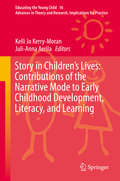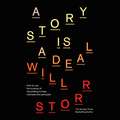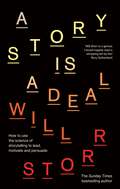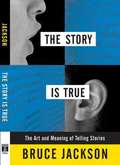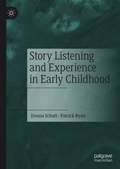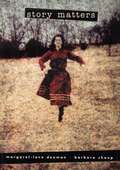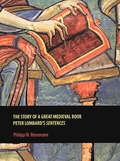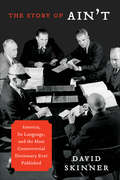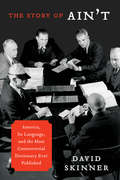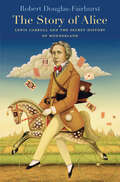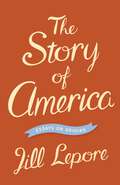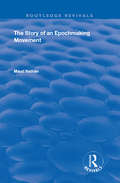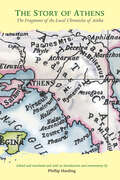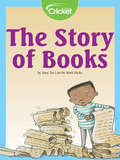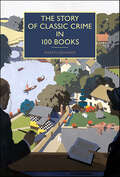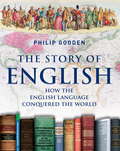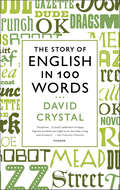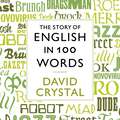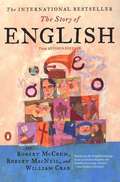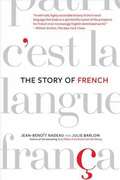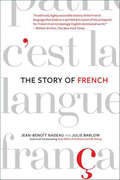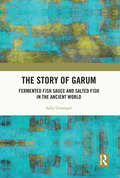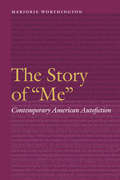- Table View
- List View
Story in Children's Lives: Contributions of the Narrative Mode to Early Childhood Development, Literacy, and Learning (Educating the Young Child #16)
by Kelli Jo Kerry-Moran Juli-Anna AerilaThis book is based on the power of stories to support children in all areas of their lives. It examines the role narratives can play in encouraging growth in contexts and domains such as personal and family identity, creative movement, memory and self-concept, social relationships, or developing a sense of humor. Each chapter describes innovative and research-based applications of narratives such as movement stories, visual narratives to develop historical thinking, multimodal storytelling, bibliotherapy, mathematics stories, family stories, and social narratives. The chapters elaborate on the strength of narratives in supporting the whole child in diverse contexts from young children on the autism spectrum improving their social skills at school, to four- and five-year-olds developing historical thinking, to children who are refugees or asylum-seekers dealing with uncertainty and loss. Written by accomplished teachers, researchers, specialists, teaching artists and teacher educators from several countries and backgrounds, the book fills a gap in the literature on narratives. “…this work delves into the topic of narratives in young children’s lives with a breadth of topics and depth of study not found elsewhere.” “Collectively, the insights of the contributors build a convincing case for emphasizing story across the various disciplines and developmental domains of the early childhood years.” “The writing style is scholarly, yet accessible. Authors used a wide array of visual material to make their points clearer and show the reader what meaningful uses of story “look like”.” Mary Renck Jalongo, Journal and Book Series Editor Springer Indiana, PA, USA
A Story is a Deal: How to use the science of storytelling to lead, motivate and persuade
by Will StorrIn this highly anticipated follow-up to the Sunday Times bestseller The Science of Storytelling, acclaimed story guru Will Storr shows you how to engage and influence your audience to create irresistible pitches, build passionate brand loyalty, motivate teams and lead with effectiveness and charisma. Using the latest findings from social psychology, evolutionary psychology, organisational psychology and neuroscience, A Story is a Deal argues that we won't unlock the true power of story if we treat it merely as something we read on a page, see on a screen or hear in a speech. Storr shows how successful stories shape identities, which changes beliefs, drives action and achieves extraordinary results. With examples ranging from Aztec rituals to Apple's legendary advertising successes (and long-forgotten fails), A Story is a Deal lays out a revolutionary new method for creating the most persuasive messaging: by harnessing the power of our storytelling brains.
A Story is a Deal: How to use the science of storytelling to lead, motivate and persuade
by Will StorrIn this highly anticipated follow-up to the Sunday Times bestseller The Science of Storytelling, acclaimed story guru Will Storr shows you how to engage and influence your audience to create irresistible pitches, build passionate brand loyalty, motivate teams and lead with effectiveness and charisma. Using the latest findings from social psychology, evolutionary psychology, organisational psychology and neuroscience, A Story is a Deal argues that we won't unlock the true power of story if we treat it merely as something we read on a page, see on a screen or hear in a speech. Storr shows how successful stories shape identities, which changes beliefs, drives action and achieves extraordinary results. With examples ranging from Aztec rituals to Apple's legendary advertising successes (and long-forgotten fails), A Story is a Deal lays out a revolutionary new method for creating the most persuasive messaging: by harnessing the power of our storytelling brains.
A Story is a Deal: How to use the science of storytelling to lead, motivate and persuade
by Will StorrIn this highly anticipated follow-up to the Sunday Times bestseller The Science of Storytelling, acclaimed story guru Will Storr shows you how to engage and influence your audience to create irresistible pitches, build passionate brand loyalty, motivate teams and lead with effectiveness and charisma. Using the latest findings from social psychology, evolutionary psychology, organisational psychology and neuroscience, A Story is a Deal argues that we won't unlock the true power of story if we treat it merely as something we read on a page, see on a screen or hear in a speech. Storr shows how successful stories shape identities, which changes beliefs, drives action and achieves extraordinary results. With examples ranging from Aztec rituals to Apple's legendary advertising successes (and long-forgotten fails), A Story is a Deal lays out a revolutionary new method for creating the most persuasive messaging: by harnessing the power of our storytelling brains.
The Story Is True: The Art and Meaning of Telling Stories
by Bruce JacksonMaking and experiencing stories, remembering and retelling them is something we all do. We tell stories over meals, at the water cooler, and to both friends and strangers. But how do stories work? What is it about telling and listening to stories that unites us? And, importantly, how do we change them-and how do they change us? InThe Story Is True, author, filmmaker, and photographer Bruce Jackson explores the ways we use the stories that become a central part of our public and private lives. He examines, as no one before has, how stories narrate and bring meaning to our lives, by describing and explaining how stories are made and used. The perspectives shared in this engaging book come from the tellers, writers, filmmakers, listeners, and watchers who create and consume stories. Jackson writes about his family and friends, acquaintances and experiences, focusing on more than a dozen personal stories, from oral histories, such as conversations the author had with poet Steven Spender, to public stories, such as what happened when Bob Dylan "went electric"at the 1965 Newport Folk Festival. Jackson also investigates how "words can kill," showing how diction can be an administrator of death, as in Nazi extermination camps. And finally, he considers the way lies come to resemble truth, showing how the stories we tell, whether true or not, resemble truth to the teller. Ultimately,The Story Is Trueis about the place of stories-fiction or real-and the impact they have on the lives of each one of us.
Story Listening and Experience in Early Childhood
by Patrick Ryan Donna SchattThis book shows connections between oral story listening and unique, enduring educational effects in and outside of the classroom. Using scientific studies and interviews, as well as personal observations from more than thirty years in schools and libraries, the authors examine learning outcomes from frequent story listening. Throughout the book, Schatt and Ryan illustrate that experiencing stories told entirely from memory transforms individuals and builds community, affecting areas such as reading comprehension, visualization, focus, flow states, empathy, attachment, and theory of mind.
Story Matters: Contemporary Short Story Writers Share the Creative Process
by Margaret-Love Denham Barbara ShoupTechniques of writing short stories; examples, advice and strategies to help you with your writing; writers explain the intent, technique, and meaning of their fiction; list of their favorite short stories; bibliography of further resources in creative writing
The Story of a Great Medieval Book: Peter Lombard's 'Sentences' (Rethinking the Middle Ages)
by Philipp W. RosemannPeter Lombard, a twelfth-century theologian, authored one of the first Western textbooks of theology, the Book of Sentences. Here, Lombard logically arranged all of the major topics of the Christian faith. His Book of Sentences received the largest number of commentaries among all works of Christian literature except for Scripture itself. Now, notable Lombard scholar Philipp W. Rosemann examines this text as a guiding thread to studying Christian thought throughout the later Middle Ages and into early modern times. This is the second title in a series called Rethinking the Middle Ages, which is committed to re-examining the Middle Ages, its themes, institutions, people, and events with short studies that will provoke discussion among students and medievalists, and invite them to think about the middle ages in new and unusual ways. The series editor, Paul Edward Dutton, invites suggestions and submissions.
The Story of Ain't: America, Its Language, and the Most Controversial Dictionary Ever Published
by David Skinner“It takes true brilliance to lift the arid tellings of lexicographic fussing into the readable realm of the thriller and the bodice-ripper….David Skinner has done precisely this, taking a fine story and honing it to popular perfection.”—Simon Winchester, New York Times bestselling author of The Professor and the MadmanThe Story of Ain’t by David Skinner is the captivating true chronicle of the creation of Merriam Webster’s Third New International Dictionary in 1961, the most controversial dictionary ever published. Skinner’s surprising and engaging, erudite and witty account will enthrall fans of Winchester’s The Professor and the Madman and The Meaning of Everything, and The Know-It-All by A.J. Jacobs, as it explores a culture in transition and the brilliant, colorful individuals behind it. The Story of Ain’t is a smart, often outrageous, and altogether remarkable tale of how egos, infighting, and controversy shaped one of America’s most authoritative language texts, sparking a furious language debate that the late, great author David Foster Wallace (Infinite Jest) once called “the Fort Sumter of the Usage Wars.”
The Story of Ain't
by David SkinnerCreated by the most respected American publisher of dictionaries and supervised by the editor Philip Gove, Webster's Third broke with tradition, adding thousands of new words and eliminating "artificial notions of correctness," basing proper usage on how language was actually spoken. The dictionary's revolutionary style sparked what David Foster Wallace called "the Fort Sumter of the Usage Wars." Editors and scholars howled for Gove's blood, calling him an enemy of clear thinking, a great relativist who was trying to sweep the English language into chaos. Critics bayed at the dictionary's permissive handling of ain't. Literary intellectuals such as Dwight Macdonald believed the dictionary's scientific approach to language and its abandonment of the old standard of usage represented the unraveling of civilization.Entertaining and erudite, The Story of Ain't describes a great societal metamorphosis, tracing the fallout of the world wars, the rise of an educated middle class, and the emergence of America as the undisputed leader of the free world, and illuminating how those forces shaped our language. Never before or since has a dictionary so embodied the cultural transformation of the United States.
The Story of Alice: Lewis Carroll and the Secret History of Wonderland
by Robert Douglas-FairhurstAn examination of the lives of author Lewis Carroll & Alice Liddell and the creation of the “Alice” stories & their ongoing popularity.Following his acclaimed life of Dickens, Robert Douglas-Fairhurst illuminates the tangled history of two lives and two books. Drawing on numerous unpublished sources, he examines in detail the peculiar friendship between the Oxford mathematician Charles Dodgson (Lewis Carroll) and Alice Liddell, the child for whom he invented the Alice stories, and analyzes how this relationship stirred Carroll’s imagination and influenced the creation of Wonderland. It also explains why Alice in Wonderland (1865) and its sequel, Through the Looking-Glass (1871), took on an unstoppable cultural momentum in the Victorian era and why, a century and a half later, they continue to enthrall and delight readers of all ages.The Story of Alice reveals Carroll as both an innovator and a stodgy traditionalist, entrenched in habits and routines. He had a keen double interest in keeping things moving and keeping them just as they are. (In Looking-Glass Land, Alice must run faster and faster just to stay in one place.) Tracing the development of the Alice books from their inception in 1862 to Liddell’s death in 1934, Douglas-Fairhurst also provides a keyhole through which to observe a larger, shifting cultural landscape: the birth of photography, changing definitions of childhood, murky questions about sex and sexuality, and the relationship between Carroll’s books and other works of Victorian literature.In the stormy transition from the Victorian to the modern era, Douglas-Fairhurst shows, Wonderland became a sheltered world apart, where the line between the actual and the possible was continually blurred.Praise for The Story of Alice“Offer[s] a thoughtful, far-reaching narrative, the story of three very different lives: those of Lewis Carroll, Alice Hargreaves, née Liddell, and the literary creation they both had a part in . . . Douglas-Fairhurst’s ability to make room for . . . doubts without giving in to them is one of his book’s great attractions.” —Michael Wood, The New York Times Book Review“Douglas-Fairhurst’s The Story of Alice belongs with the best books ever written in the field of Carrollian studies . . . For a total work of criticism . . . The Story of Alice can’t be beat. In it, Douglas-Fairhurst examines the tangled lives of Carroll and Alice Liddell (later Alice Hargreaves) up until the latter’s death in 1934, while also tracking the publication history of the ‘Alice’ books, their popularity and their ongoing cultural influence. The Oxford don’s own prose is, moreover, a delight to read: fact-filled, nicely balanced between exposition and quotation, confiding and witty. In fact, high among the pleasures of The Story of Alice is its willingness to amuse as well as instruct.” —Michael Dirda, The Washington Post
The Story of America: Essays on Origins
by Jill LeporeFrom celebrated writer Jill Lepore, a literary and political history of American origin stories In The Story of America, Harvard historian and New Yorker staff writer Jill Lepore investigates American origin stories—from John Smith's account of the founding of Jamestown in 1607 to Barack Obama's 2009 inaugural address—to show how American democracy is bound up with the history of print. Over the centuries, Americans have read and written their way into a political culture of ink and type.Part civics primer, part cultural history, The Story of America excavates the origins of everything from the paper ballot and the Constitution to the I.O.U. and the dictionary. Along the way it presents fresh readings of Benjamin Franklin's Way to Wealth, Thomas Paine's Common Sense, "The Raven" by Edgar Allan Poe, and "Paul Revere's Ride" by Henry Wadsworth Longfellow, as well as histories of lesser-known genres, including biographies of presidents, novels of immigrants, and accounts of the Depression.From past to present, Lepore argues, Americans have wrestled with the idea of democracy by telling stories. In this thoughtful and provocative book, Lepore offers at once a history of origin stories and a meditation on storytelling itself.
The Story of an Epoch Making Movement (Routledge Revivals)
by Maud NathanPublished in 1926: The author tells the story of the Consumers’ League from the genesis of the idea through the days of its development to its present days of power.
The Story of Athens: The Fragments of the Local Chronicles of Attika (Routledge Sourcebooks for the Ancient World)
by Phillip HardingA leading authority in the field, Phillip Harding presents the very first English translations of the six Athenian writers known as the Atthidographers. In his vivid and detailed history, Harding examines the remaining fragments of these historical writers' work – in chronological order – and how these writings, dating from the fifth and fourth century BC, reveal an invaluable wealth of information about early Athenian history, legend, religion, customs and anecdotes. Harding also goes on to study how these histories of Athens and its people were the source for later surviving historians such as Plutarch and Diodorus. With the aid of linking text and detailed annotation, anyone with an interest in Athenian history, classical Greece need look no further.
The Story of Books
by Amy TaoSince ancient times, people have been recording information. Books—as we know them today—took many centuries to evolve.
The Story of Classic Crime in 100 Books
by Martin Edwards&“This is an exemplary reference book sure to lead readers to gems of mystery and detective fiction.&” —Publishers Weekly, starred review This book tells the story of crime fiction published during the first half of the twentieth century. The diversity of this much-loved genre is breathtaking, and so much greater than many critics have suggested. To illustrate this, the leading expert on classic crime discusses one hundred books ranging from The Hound of the Baskervilles to Strangers on a Train which highlight the entertaining plots, the literary achievements, and the social significance of vintage crime fiction. This book serves as a companion to the acclaimed British Library Crime Classics series but it tells a very diverse story. It presents the development of crime fiction—from Sherlock Holmes to the end of the golden age—in an accessible, informative and engaging style. Readers who enjoy classic crime will make fascinating discoveries and learn about forgotten gems as well as bestselling authors. Even the most widely read connoisseurs will find books (and trivia) with which they are unfamiliar—as well as unexpected choices to debate. Classic crime is a richly varied and deeply pleasurable genre that is enjoying a world-wide renaissance as dozens of neglected novels and stories are resurrected for modern readers to enjoy. The overriding aim of this book is to provide a launch point that enables readers to embark on their own voyages of discovery.
The Story of English: How the English language conquered the world
by Philip GoodenBorn as a Germanic tongue with the arrival in Britain of the Anglo-Saxons in the early medieval period, heavily influenced by Norman French from the 11th century, and finally emerging as modern English from the late Middle Ages, the English language has grown to become the linguistic equivalent of a superpower.Worldwide some 380 million people speak English as a first language and some 600 million as a second language. A staggering one billion people are believed to be learning it. English is the premier international language in communications, science, business, aviation, entertainment, and diplomacy, and also on the Internet and is thought by many to be well on the way to becoming the world's first universal language. Philip Gooden tells the story of the English language in all its richness and variety. From the intriguing origins and changing definitions of common words such as 'OK', 'beserk', 'curfew', 'cabal' and 'pow-wow', to the massive transformations wrought in the vocabulary and structure of the language by Anglo-Saxon and Norman conquest, through to the literary triumphs of Beowulf, The Canterbury Tales and the works of Shakespeare, right up to the profound and surprising effect electronic media, and in particular the Internet, has had on its development.
The Story of English: How the English language conquered the world
by Philip GoodenBorn as a Germanic tongue with the arrival in Britain of the Anglo-Saxons in the early medieval period, heavily influenced by Norman French from the 11th century, and finally emerging as modern English from the late Middle Ages, the English language has grown to become the linguistic equivalent of a superpower.Worldwide some 380 million people speak English as a first language and some 600 million as a second language. A staggering one billion people are believed to be learning it. English is the premier international language in communications, science, business, aviation, entertainment, and diplomacy, and also on the Internet and is thought by many to be well on the way to becoming the world's first universal language. Philip Gooden tells the story of the English language in all its richness and variety. From the intriguing origins and changing definitions of common words such as 'OK', 'beserk', 'curfew', 'cabal' and 'pow-wow', to the massive transformations wrought in the vocabulary and structure of the language by Anglo-Saxon and Norman conquest, through to the literary triumphs of Beowulf, The Canterbury Tales and the works of Shakespeare, right up to the profound and surprising effect electronic media, and in particular the Internet, has had on its development.
The Story of English in 100 Words
by David CrystalThe world’s foremost expert on the English language takes us on an entertaining and eye-opening tour of the history of our vernacular through the ages.In The Story of English in 100 Words, an entertaining history of the world’s most ubiquitous language, David Crystal draws on one hundred words that best illustrate the huge variety of sources, influences and events that have helped to shape our vernacular since the first definitively English word—“roe”—was written down on the femur of a roe deer in the fifth century. Featuring ancient words (“loaf”), cutting edge terms that reflect our world (“twittersphere”), indispensable words that shape our tongue (“and,” “what”), fanciful words (“fopdoodle”) and even obscene expressions (the “c word”), David Crystal takes readers on a tour of the winding byways of our language via the rude, the obscure and the downright surprising.“From pre-eminent British linguist Crystal . . . comes this delightful history of the words we use (and some we’ve forgotten) and how we came to use them. . . . Crystal’s enthusiasm for—and wealth of knowledge about—the ever-evolving English language makes this a must-read for word lovers.” —Publishers Weekly (starred review)
The Story of English in 100 Words
by Professor David CrystalIn this unique new history of the world's most ubiquitous language, linguistics expert David Crystal draws on words that best illustrate the huge variety of sources, influences and events that have helped to shape our vernacular since the first definitively English word was written down in the fifth century ('roe', in case you are wondering).Featuring Latinate and Celtic words, weasel words and nonce-words, ancient words ('loaf') to cutting edge ('twittersphere') and spanning the indispensable words that shape our tongue ('and', 'what') to the more fanciful ('fopdoodle'), Crystal takes us along the winding byways of language via the rude, the obscure and the downright surprising.
The Story Of English, Third Revised Edition
by Robert Mccrum William Cran Robert MacneilNow revised, The Story of English is the first book to tell the whole story of the English language. Originally paired with a major PBS miniseries, this book presents a stimulating and comprehensive record of spoken and written English—from its Anglo-Saxon origins some two thousand years ago to the present day, when English is the dominant language of commerce and culture with more than one billion English speakers around the world. From Cockney, Scouse, and Scots to Gulla, Singlish, Franglais, and the latest African American slang, this sweeping history of the English language is the essential introduction for anyone who wants to know more about our common tongue.
The Story of French
by Jean-Benoît Nadeau Julie BarlowImagine a language with rules so complex that few people ever master it and whose speakers spend millions of dollars every year to make sure it gets used in literature, music, and film. Consider the fact that this language is second only to English for the number of countries where it is officially spoken and that its speakers have tripled in the last fifty years. While it frightens users with its nuances, millions still seek the romance and refinement assocaited with it. The language is French and this is its story. In a captivating narrative that spans the ages, from Charlemagne to Cirque du Soleil, Jean-Benoît Nadeau and Julie Barlow unravel the mysteries of a language that has maintained its global influence despite the rise of English. The Story of French is one of spectacular failures and unexpected successes and includes some of history]s and literature's greatest figures--from William the Conquerer to Cardinal Richelieu, Madame Curie to Simone de Beauvoir. Through this colorful history, Nadeau and Barlow illustrate how French acquired its own peculiar culture. They reveal how the culture of the language spread among francophones the world over yet remains curiously centered on Paris. As lively as it is fascinating, The Story of French challenges long-held assumptions about French and explains why it is still the world's other global language.
The Story of French
by Jean-Benoît Nadeau Julie BarlowWhy does everything sound better if it's said in French? That fascination is at the heart of The Story of French, the first history of one of the most beautiful languages in the world that was, at one time, the pre-eminent language of literature, science and diplomacy. In a captivating narrative that spans the ages, from Charlemagne to Cirque du Soleil, Jean-Benoît Nadeau and Julie Barlow unravel the mysteries of a language that has maintained its global influence despite the rise of English. As in any good story, The Story of French has spectacular failures, unexpected successes and bears traces of some of history's greatest figures: the tenacity of William the Conqueror, the staunchness of Cardinal Richelieu, and the endurance of the Lewis and Clark expedition. Through this colorful history, Nadeau and Barlow illustrate how French acquired its own peculiar culture, revealing how the culture of the language spread among francophones the world over and yet remains curiously centered in Paris. In fact, French is not only thriving—it still has a surprisingly strong influence on other languages. As lively as it is fascinating, The Story of French challenges long held assumptions about French and shows why it is still the world's other global language.
The Story of Garum: Fermented Fish Sauce and Salted Fish in the Ancient World
by Sally GraingerThe Story of Garum recounts the convoluted journey of that notorious Roman fish sauce, known as garum, from a smelly Greek fish paste to an expensive luxury at the heart of Roman cuisine and back to obscurity as the Roman empire declines. This book is a unique attempt to meld the very disparate disciplines of ancient history, classical literature, archaeology, zooarchaeology, experimental archaeology, ethnographic studies and modern sciences to illuminate this little understood commodity. Currently Roman fish sauce has many identities depending on which discipline engages with it, in what era and at what level. These identities are often contradictory and confused and as yet no one has attempted a holistic approach where fish sauce has been given centre stage. Roman fish sauce, along with oil and wine, formed a triad of commodities which dominated Mediterranean trade and while oil and wine can be understood, fish sauce was until now a mystery. Students and specialists in the archaeology of ancient Mediterranean trade whether through amphora studies, shipwrecks or zooarchaeology will find this invaluable. Scholars of ancient history and classics wishing to understand the nuances of Roman dining literature and the wider food history discipline will also benefit from this volume.
The Story of "Me": Contemporary American Autofiction (Frontiers of Narrative)
by Marjorie WorthingtonAutofiction, or works in which the eponymous author appears as a fictionalized character, represents a significant trend in postwar American literature, when it proliferated to become a kind of postmodern cliché. The Story of “Me” charts the history and development of this genre, analyzing its narratological effects and discussing its cultural implications. By tracing autofiction’s conceptual issues through case studies and an array of texts, Marjorie Worthington sheds light on a number of issues for postwar American writing: the maleness of the postmodern canon—and anxieties created by the supposed waning of male privilege—the relationship between celebrity and authorship, the influence of theory, the angst stemming from claims of the “death of the author,” and the rise of memoir culture. Worthington constructs and contextualizes a bridge between the French literary context, from which the term originated, and the rise of autofiction among various American literary movements, from modernism to New Criticism to New Journalism. The Story of “Me” demonstrates that the burgeoning of autofiction serves as a barometer of American literature, from modernist authorial effacement to postmodern literary self-consciousness.
